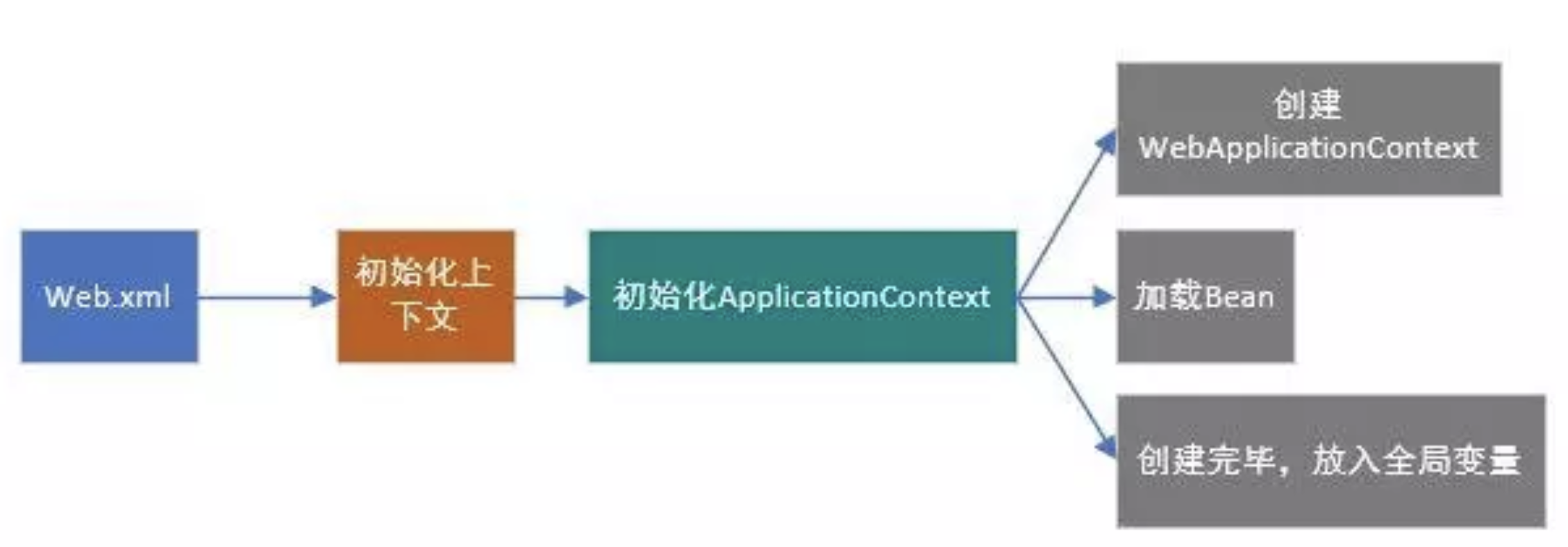Spring的启动流程
spring的启动是建筑在servlet容器之上的,所有web工程的初始位置就是web.xml,它配置了servlet的上下文(context)和监听器(Listener),下面就来看看web.xml里面的配置:
<!--上下文监听器,用于监听servlet的启动过程-->
<listener>
<description>ServletContextListener</description>
<!--这里是自定义监听器,个性化定制项目启动提示-->
<listener-class>com.trace.app.framework.listeners.ApplicationListener</listener-class>
</listener> <!--dispatcherServlet的配置,这个servlet主要用于前端控制,这是springMVC的基础-->
<servlet>
<servlet-name>service_dispatcher</servlet-name>
<servlet-class>org.springframework.web.servlet.DispatcherServlet</servlet-class>
<init-param>
<param-name>contextConfigLocation</param-name>
<param-value>/WEB-INF/spring/services/service_dispatcher-servlet.xml</param-value>
</init-param>
<load-on-startup>1</load-on-startup>
</servlet> <!--spring资源上下文定义,在指定地址找到spring的xml配置文件-->
<context-param>
<param-name>contextConfigLocation</param-name>
<param-value>/WEB-INF/spring/application_context.xml</param-value>
</context-param>
<!--spring的上下文监听器-->
<listener>
<listener-class>
org.springframework.web.context.ContextLoaderListener
</listener-class>
</listener> <!--Session监听器,Session作为公共资源存在上下文资源当中,这里也是自定义监听器-->
<listener>
<listener-class>
com.trace.app.framework.listeners.MySessionListener
</listener-class>
</listener>
接下来就一点的来解析这样一个启动过程。
1. spring的上下文监听器
代码如下:
<!--spring资源上下文定义,在指定地址找到spring的xml配置文件-->
<context-param>
<param-name>contextConfigLocation</param-name>
<param-value>/WEB-INF/spring/application_context.xml</param-value>
</context-param>
<!--spring的上下文监听器-->
<listener>
<listener-class>
org.springframework.web.context.ContextLoaderListener
</listener-class>
</listener>
spring的启动其实就是IOC容器的启动过程,通过上述的第一段配置<context-param>是初始化上下文,然后通过后一段的的<listener>来加载配置文件,其中调用的spring包中的ContextLoaderListener这个上下文监听器,ContextLoaderListener是一个实现了ServletContextListener接口的监听器,他的父类是 ContextLoader,在启动项目时会触发contextInitialized上下文初始化方法。下面我们来看看这个方法:
public void contextInitialized(ServletContextEvent event) {
initWebApplicationContext(event.getServletContext());
}
可以看到,这里是调用了父类ContextLoader的initWebApplicationContext(event.getServletContext());方法,很显然,这是对ApplicationContext的初始化方法,也就是到这里正是进入了springIOC的初始化。
接下来再来看看initWebApplicationContext又做了什么工作,先看看代码:
if (servletContext.getAttribute(WebApplicationContext.ROOT_WEB_APPLICATION_CONTEXT_ATTRIBUTE) != null) {
throw new IllegalStateException(
"Cannot initialize context because there is already a root application context present - " +
"check whether you have multiple ContextLoader* definitions in your web.xml!");
}
Log logger = LogFactory.getLog(ContextLoader.class);
servletContext.log("Initializing Spring root WebApplicationContext");
if (logger.isInfoEnabled()) {
logger.info("Root WebApplicationContext: initialization started");
}
long startTime = System.currentTimeMillis();
try {
// Store context in local instance variable, to guarantee that
// it is available on ServletContext shutdown.
if (this.context == null) {
this.context = createWebApplicationContext(servletContext);
}
if (this.context instanceof ConfigurableWebApplicationContext) {
ConfigurableWebApplicationContext cwac = (ConfigurableWebApplicationContext) this.context;
if (!cwac.isActive()) {
// The context has not yet been refreshed -> provide services such as
// setting the parent context, setting the application context id, etc
if (cwac.getParent() == null) {
// The context instance was injected without an explicit parent ->
// determine parent for root web application context, if any.
ApplicationContext parent = loadParentContext(servletContext);
cwac.setParent(parent);
}
configureAndRefreshWebApplicationContext(cwac, servletContext);
}
}
servletContext.setAttribute(WebApplicationContext.ROOT_WEB_APPLICATION_CONTEXT_ATTRIBUTE, this.context);
ClassLoader ccl = Thread.currentThread().getContextClassLoader();
if (ccl == ContextLoader.class.getClassLoader()) {
currentContext = this.context;
}
else if (ccl != null) {
currentContextPerThread.put(ccl, this.context);
}
if (logger.isDebugEnabled()) {
logger.debug("Published root WebApplicationContext as ServletContext attribute with name [" +
WebApplicationContext.ROOT_WEB_APPLICATION_CONTEXT_ATTRIBUTE + "]");
}
if (logger.isInfoEnabled()) {
long elapsedTime = System.currentTimeMillis() - startTime;
logger.info("Root WebApplicationContext: initialization completed in " + elapsedTime + " ms");
}
return this.context;
}
catch (RuntimeException ex) {
logger.error("Context initialization failed", ex);
servletContext.setAttribute(WebApplicationContext.ROOT_WEB_APPLICATION_CONTEXT_ATTRIBUTE, ex);
throw ex;
}
catch (Error err) {
logger.error("Context initialization failed", err);
servletContext.setAttribute(WebApplicationContext.ROOT_WEB_APPLICATION_CONTEXT_ATTRIBUTE, err);
throw err;
}
这个方法还是有点长的,其实仔细看看,出去异常错误处理,这个方法主要做了三件事:
- 创建WebApplicationContext。
- 加载对应的spring配置文件中的Bean。
- 将WebApplicationContext放入ServletContext(Java Web的全局变量)中。
上述代码中createWebApplicationContext(servletContext)方法即是完成创建WebApplicationContext工作,也就是说这个方法创建了上下文对象,支持用户自定义上下文对象,但必须继承ConfigurableWebApplicationContext,而Spring MVC默认使用ConfigurableWebApplicationContext作为ApplicationContext(它仅仅是一个接口)的实现。
再往下走,有一个方法configureAndRefreshWebApplicationContext就是用来加载spring配置文件中的Bean实例的。这个方法于封装ApplicationContext数据并且初始化所有相关Bean对象。它会从web.xml中读取名为 contextConfigLocation的配置,这就是spring xml数据源设置,然后放到ApplicationContext中,最后调用传说中的refresh方法执行所有Java对象的创建。
最后完成ApplicationContext创建之后就是将其放入ServletContext中,注意它存储的key值常量。
servletContext.setAttribute(WebApplicationContext.ROOT_WEB_APPLICATION_CONTEXT_ATTRIBUTE, this.context);
总结来说如下图:

2.SpringMVC的启动过程
web.xml的相关配置:
<!--dispatcherServlet的配置,这个servlet主要用于前端控制,这是springMVC的基础-->
<servlet>
<servlet-name>service_dispatcher</servlet-name>
<servlet-class>org.springframework.web.servlet.DispatcherServlet</servlet-class>
<init-param>
<param-name>contextConfigLocation</param-name>
<param-value>/WEB-INF/spring/services/service_dispatcher-servlet.xml</param-value>
</init-param>
<load-on-startup>1</load-on-startup>
</servlet>
这里采用这种自定义初始化参数的配置方式,当然也可以使用默认的。这里Spring Web MVC框架将加载“classpath:service_dispatcher-servlet.xml”来进行初始化上下文而不是“/WEB-INF/[servlet名字]-servlet.xml”。
通过上述配置文件很明显可以看出,springMVC的起始位置是DispatcherServlet(还是spring提供的)
public class DispatcherServlet extends FrameworkServlet {
... ...
}
这个类的父类是FrameworkServlet,FrameworkServlet又继承了HttpServletBean类,HttpServletBean又继承了HttpServlet,HttpServlet继承了GenericServlet。
public abstract class FrameworkServlet extends HttpServletBean implements ApplicationContextAware {
... ...
}
public abstract class HttpServletBean extends HttpServlet
implements EnvironmentCapable, EnvironmentAware {
... ...
}
public abstract class HttpServlet extends GenericServlet
implements java.io.Serializable
{
... ...
}
所以在这样一个web容器启动的时候会调用HttpServletBean的init方法,这个方法覆盖了GenericServlet中的init方法。让我我们来看看代码:
@Override
public final void init() throws ServletException {
if (logger.isDebugEnabled()) {
logger.debug("Initializing servlet '" + getServletName() + "'");
} // Set bean properties from init parameters.
try {
PropertyValues pvs = new ServletConfigPropertyValues(getServletConfig(), this.requiredProperties);
BeanWrapper bw = PropertyAccessorFactory.forBeanPropertyAccess(this);
ResourceLoader resourceLoader = new ServletContextResourceLoader(getServletContext());
bw.registerCustomEditor(Resource.class, new ResourceEditor(resourceLoader, getEnvironment()));
initBeanWrapper(bw);
bw.setPropertyValues(pvs, true);
}
catch (BeansException ex) {
logger.error("Failed to set bean properties on servlet '" + getServletName() + "'", ex);
throw ex;
} // Let subclasses do whatever initialization they like.
initServletBean(); if (logger.isDebugEnabled()) {
logger.debug("Servlet '" + getServletName() + "' configured successfully");
}
}
该初始化方法的主要作用:将Servlet初始化参数(init-param)设置到该组件上(如contextAttribute、contextClass、namespace、contextConfigLocation),通过BeanWrapper简化设值过程,方便后续使用;提供给子类初始化扩展点,initServletBean(),该方法由FrameworkServlet覆盖。
FrameworkServlet继承HttpServletBean,通过initServletBean()进行Web上下文初始化,该方法主要覆盖一下两件事情:初始化web上下文;提供给子类初始化扩展点。
@Override
protected final void initServletBean() throws ServletException {
getServletContext().log("Initializing Spring FrameworkServlet '" + getServletName() + "'");
if (this.logger.isInfoEnabled()) {
this.logger.info("FrameworkServlet '" + getServletName() + "': initialization started");
}
long startTime = System.currentTimeMillis(); try {
this.webApplicationContext = initWebApplicationContext();
initFrameworkServlet();
}
catch (ServletException ex) {
this.logger.error("Context initialization failed", ex);
throw ex;
}
catch (RuntimeException ex) {
this.logger.error("Context initialization failed", ex);
throw ex;
} if (this.logger.isInfoEnabled()) {
long elapsedTime = System.currentTimeMillis() - startTime;
this.logger.info("FrameworkServlet '" + getServletName() + "': initialization completed in " +
elapsedTime + " ms");
}
}
DispatcherServlet继承FrameworkServlet,并实现了onRefresh()方法提供一些前端控制器相关的配置。
整个DispatcherServlet初始化的过程和做了些什么事情,具体主要做了如下两件事情:
1、初始化Spring Web MVC使用的Web上下文,并且指定父容器为WebApplicationContext(ContextLoaderListener加载了的根上下文);
2、初始化DispatcherServlet使用的策略,如HandlerMapping、HandlerAdapter等。
onRefresh方法代码如下:
@Override
protected void onRefresh(ApplicationContext context) {
initStrategies(context);
} /**
* Initialize the strategy objects that this servlet uses.
* <p>May be overridden in subclasses in order to initialize further strategy objects.
*/
protected void initStrategies(ApplicationContext context) {
initMultipartResolver(context);
initLocaleResolver(context);
initThemeResolver(context);
initHandlerMappings(context);
initHandlerAdapters(context);
initHandlerExceptionResolvers(context);
initRequestToViewNameTranslator(context);
initViewResolvers(context);
initFlashMapManager(context);
}
总结
1. 首先,对于一个web应用,其部署在web容器中,web容器提供其一个全局的上下文环境,这个上下文就是ServletContext,其为后面的spring IoC容器提供宿主环境;
2. 其 次,在web.xml中会提供有contextLoaderListener。在web容器启动时,会触发容器初始化事件,此时 contextLoaderListener会监听到这个事件,其contextInitialized方法会被调用,在这个方法中,spring会初始化一个启动上下文,这个上下文被称为根上下文,即WebApplicationContext,这是一个接口类,确切的说,其实际的实现类是 XmlWebApplicationContext。这个就是spring的IoC容器,其对应的Bean定义的配置由web.xml中的 context-param标签指定。在这个IoC容器初始化完毕后,spring以WebApplicationContext.ROOTWEBAPPLICATIONCONTEXTATTRIBUTE为属性Key,将其存储到ServletContext中,便于获取;
3. 再 次,contextLoaderListener监听器初始化完毕后,开始初始化web.xml中配置的Servlet,这里是DispatcherServlet,这个servlet实际上是一个标准的前端控制器,用以转发、匹配、处理每个servlet请 求。DispatcherServlet上下文在初始化的时候会建立自己的IoC上下文,用以持有spring mvc相关的bean。在建立DispatcherServlet自己的IoC上下文时,会利用WebApplicationContext.ROOTWEBAPPLICATIONCONTEXTATTRIBUTE先从ServletContext中获取之前的根上下文(即WebApplicationContext)作为自己上下文的parent上下文。有了这个 parent上下文之后,再初始化自己持有的上下文。这个DispatcherServlet初始化自己上下文的工作在其initStrategies方 法中可以看到,大概的工作就是初始化处理器映射、视图解析等。这个servlet自己持有的上下文默认实现类也是 XmlWebApplicationContext。初始化完毕后,spring以与servlet的名字相关(此处不是简单的以servlet名为 Key,而是通过一些转换,具体可自行查看源码)的属性为属性Key,也将其存到ServletContext中,以便后续使用。这样每个servlet 就持有自己的上下文,即拥有自己独立的bean空间,同时各个servlet共享相同的bean,即根上下文(第2步中初始化的上下文)定义的那些 bean。
Spring的启动流程的更多相关文章
- Spring Boot启动流程分析
引言 早在15年的时候就开始用spring boot进行开发了,然而一直就只是用用,并没有深入去了解spring boot是以什么原理怎样工作的,说来也惭愧.今天让我们从spring boot启动开始 ...
- Spring Boot启动流程详解(一)
环境 本文基于Spring Boot版本1.3.3, 使用了spring-boot-starter-web. 配置完成后,编写了代码如下: @SpringBootApplication public ...
- Spring Boot启动流程详解
注:本文转自http://zhaox.github.io/java/2016/03/22/spring-boot-start-flow 环境 本文基于Spring Boot版本1.3.3, 使用了sp ...
- Spring|IOC启动流程
1.IOC启动流程 IOC的启动流程分为两个阶段,第一阶段是容器的启动阶段,第二阶段是Bean实例化阶段. 容器的启动阶段:加载配置信息,分析配置信息,其他 Bean实例化阶段:实例化对象,装配依赖, ...
- Spring MVC启动流程分析
本文是Spring MVC系列博客的第一篇,后续会汇总成贴子. Spring MVC是Spring系列框架中使用频率最高的部分.不管是Spring Boot还是传统的Spring项目,只要是Web项目 ...
- Spring Boot -- 启动流程分析之ApplicationContext 中
上一节我们已经分析到AbsractApplicationContext类refresh方法中的postProcessBeanFactory方法,在分析registerBeanPostProcessor ...
- Spring Boot(三):Spring Boot中的事件的使用 与Spring Boot启动流程(Event 事件 和 Listeners监听器)
前言:在讲述内容之前 希望大家对设计模式有所了解 即使你学会了本片的内容 也不知道什么时候去使用 或者为什么要这样去用 观察者模式: 观察者模式是一种对象行为模式.它定义对象间的一种一对多的依赖关系, ...
- web中spring框架启动流程第一发
web.xml中springmvc相关配置如下:<servlet> <servlet-name>springmvc</servlet-name> <servl ...
- Spring Boot启动流程
基础准备 1,BeanPostProcessor:这个接口的作用在于对于新构造的实例可以做一些自定义的修改.比如如何构造.属性值的修改.构造器的选择等等 2,BeanFactoryPostProces ...
随机推荐
- sonar:sonarqube6.7.6与mysql5.7版本不匹配
问题 更换sonarqube的数据库为mysql后,启动sonarqube,提示Database was upgraded to a more recent of SonarQube. 解决: 将so ...
- 怎么理解linux作业(job),与进程(process)的关系
1.相关概念: shell :命令解释器,其实就是一个脚本语言解释器,有很多种(bash,ash,tcsh等),最常用的是bash. job(作业): 是相对shell 来说的,在shell中执行一条 ...
- canvas入门级基本用法实现雨滴下落特效
canvas基础知识点参考各种文档,直接上代码,有非常详细注释 <!DOCTYPE html> <html> <head> <meta charset=&qu ...
- c++学习笔记_6
前言:本笔记所对应的课程为中国大学mooc中北京大学的程序设计与算法(三)C++面向对象程序设计,主要供自己复习使用,且本笔记建立在会使用c和java的基础上,只针对与c和java的不同来写 多态 虚 ...
- 最新 前程无忧java校招面经 (含整理过的面试题大全)
从6月到10月,经过4个月努力和坚持,自己有幸拿到了网易雷火.京东.去哪儿.前程无忧等10家互联网公司的校招Offer,因为某些自身原因最终选择了前程无忧.6.7月主要是做系统复习.项目复盘.Leet ...
- 使用js加载器动态加载外部js、css文件
let MiniSite = new Object(); /** * 判断浏览器 */ MiniSite.Browser = { ie: /msie/.test(window.navigator.us ...
- Linux下运行《UNIX环境高级编程》undefined reference to `err_quit 编译出错的处理方法
错误信息: : undefined reference to `err_quit': undefined reference to `err_sys' 解决方法: 因为err_quit跟err_sys ...
- 轻松搞定Vue 使用SignalR与Asp.net Core通讯
前言 针对于Web与其他应用的的通讯,在.Net中,SignalR是一个不错的选择,在前后端没有分离的时候,直接引用对应的signalr.js文件即可: 这里主要记录Vue与Asp.netcore 前 ...
- 【leetcode算法-简单】1.两数之和
[题目描述] 给定一个整数数组 nums 和一个目标值 target,请你在该数组中找出和为目标值的那 两个 整数,并返回他们的数组下标. 你可以假设每种输入只会对应一个答案.但是,你不能重复利用这个 ...
- js复制文本
第一种: 自己测试时 只适合于input 和textarea 但是针对于其他标签的复制就不能用了.代码如下: <!DOCTYPE html> <html> <head&g ...
